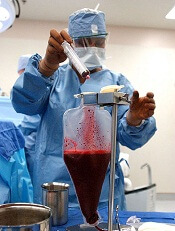
Photo by Chad McNeeley
A retrospective study has shown that, since the 1980s, the world has seen a substantial increase in the use of hematopoietic stem cell transplants (HSCTs) and a significant rise in the number of donor registries.
Still, it seems many patients who would benefit from HSCT do not undergo the procedure due to a chronic shortage of resources and donors.
Dietger Niederwieser, MD, of the University Hospital Leipzig in Germany, and his colleagues recounted these findings in The Lancet Haematology.
Using data collected by the Worldwide Network for Blood and Marrow Transplantation (WBMT), the researchers systematically analyzed the growth of HSCT and changes in its use in 194 WHO member countries since the first HSCT was performed in 1957.
The team also examined the link between macroeconomic factors (eg, gross national income and healthcare expenditure) and transplant frequencies per 10 million inhabitants in each country.
The data showed that about 10,000 HSCTs had been performed by 1985, but that number rose to around 100,000 by 1995. By December 2012, nearly 1 million HSCTs—42% allogeneic and 58% autologous—had been performed at 1516 transplant centers across 75 countries.
Transplants were more common in countries with greater financial resources, more transplant teams, and an unrelated donor infrastructure. Most transplants were performed in Europe (53%), followed by the Americas (31%), South East Asia and the Western Pacific (15%), and the Eastern Mediterranean and Africa (2%).
The use of allogeneic HSCT has grown rapidly in all regions, without any signs of saturation. This likely reflects substantial underuse of this therapy, according to the researchers. And it suggests more patients would have received allogeneic transplants if they were accessible or suitable donors were available.
On the other hand, the researchers found that the number of countries with donor registries increased from 2 in 1987 to 57 in 2012. And the number of volunteer donors rose from 3072 in 1987 to over 22 million in 2012.
The international exchange of stem cell products also increased to more than 10,000 a year between 2006 and 2012, with substantial differences between countries in the amount of stem cells they import or export.
Despite these increases, the researchers noted that there are still too many patients who are unable to find a suitable donor. At any time, more than 37,000 people worldwide are waiting for an HSC donation.
“Patients, many of them children, are facing a life-and-death situation,” Dr Niederwieser said. “Ultimately, they will die if they cannot get the treatment they need. All countries need to provide adequate infrastructure for patients and donors to make sure that everyone who needs a transplant gets one, rather than the present situation in which access remains restricted to countries and people with sufficient resources.”


